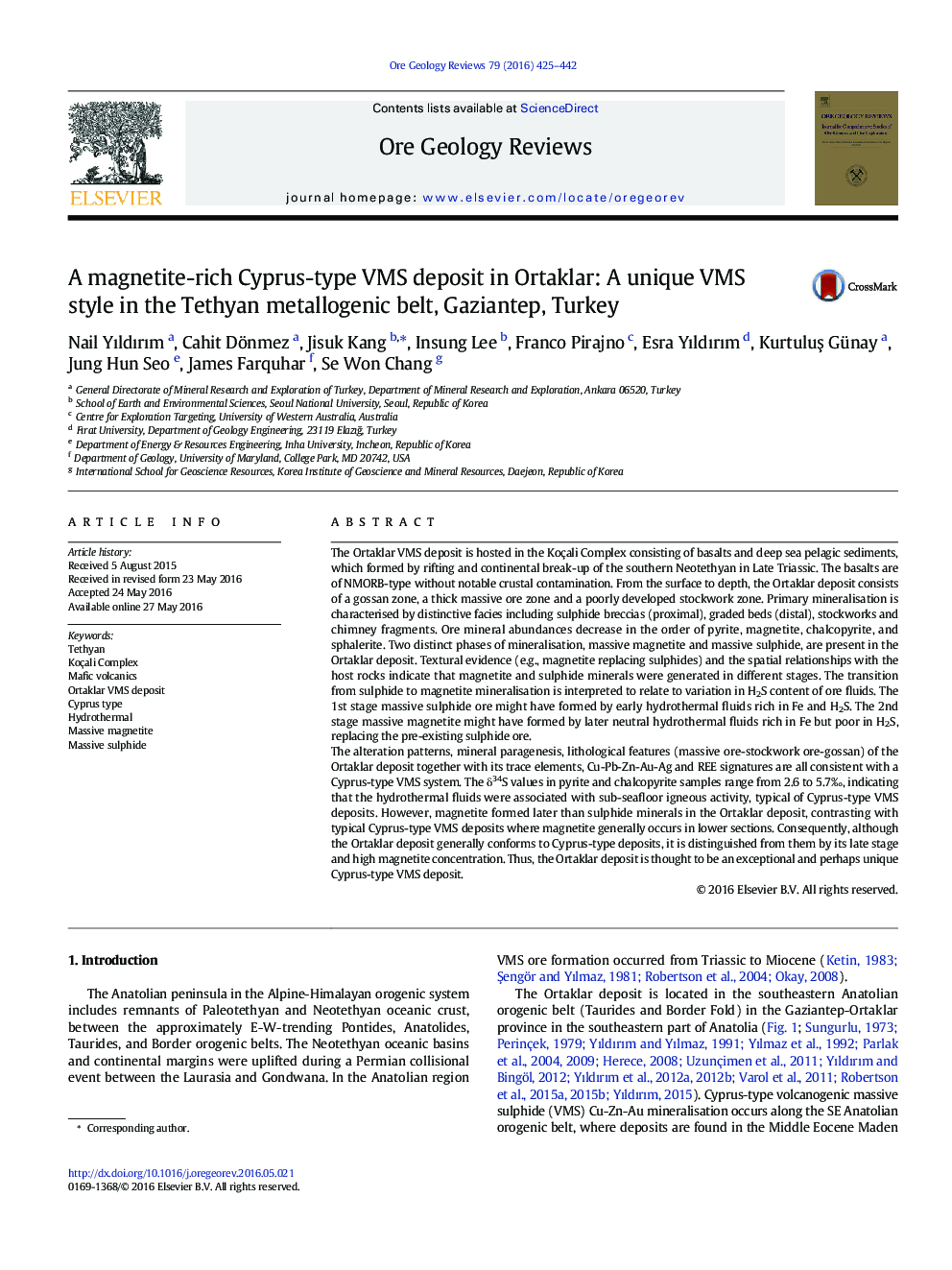| کد مقاله | کد نشریه | سال انتشار | مقاله انگلیسی | نسخه تمام متن |
|---|---|---|---|---|
| 4696807 | 1637227 | 2016 | 18 صفحه PDF | دانلود رایگان |

• The Ortaklar deposit is hosted by pillow basalts in the Koçali Complex which was formed by the rifting of Southern Neotethys Ocean in Late Triassic.
• Two distinct phases of mineralization, massive magnetite and massive sulphide, are present in the Ortaklar deposit.
• It is similar to Cyprus-type VMS deposits in the southern Tethyan belt with its alteration patterns, mineral paragenesis and host lithology.
• It is a unique VMS mineralization in the Tethyan metallogenic belt, because of its high magnetite content.
The Ortaklar VMS deposit is hosted in the Koçali Complex consisting of basalts and deep sea pelagic sediments, which formed by rifting and continental break-up of the southern Neotethyan in Late Triassic. The basalts are of NMORB-type without notable crustal contamination. From the surface to depth, the Ortaklar deposit consists of a gossan zone, a thick massive ore zone and a poorly developed stockwork zone. Primary mineralisation is characterised by distinctive facies including sulphide breccias (proximal), graded beds (distal), stockworks and chimney fragments. Ore mineral abundances decrease in the order of pyrite, magnetite, chalcopyrite, and sphalerite. Two distinct phases of mineralisation, massive magnetite and massive sulphide, are present in the Ortaklar deposit. Textural evidence (e.g., magnetite replacing sulphides) and the spatial relationships with the host rocks indicate that magnetite and sulphide minerals were generated in different stages. The transition from sulphide to magnetite mineralisation is interpreted to relate to variation in H2S content of ore fluids. The 1st stage massive sulphide ore might have formed by early hydrothermal fluids rich in Fe and H2S. The 2nd stage massive magnetite might have formed by later neutral hydrothermal fluids rich in Fe but poor in H2S, replacing the pre-existing sulphide ore.The alteration patterns, mineral paragenesis, lithological features (massive ore-stockwork ore-gossan) of the Ortaklar deposit together with its trace elements, Cu-Pb-Zn-Au-Ag and REE signatures are all consistent with a Cyprus-type VMS system. The δ34S values in pyrite and chalcopyrite samples range from 2.6 to 5.7‰, indicating that the hydrothermal fluids were associated with sub-seafloor igneous activity, typical of Cyprus-type VMS deposits. However, magnetite formed later than sulphide minerals in the Ortaklar deposit, contrasting with typical Cyprus-type VMS deposits where magnetite generally occurs in lower sections. Consequently, although the Ortaklar deposit generally conforms to Cyprus-type deposits, it is distinguished from them by its late stage and high magnetite concentration. Thus, the Ortaklar deposit is thought to be an exceptional and perhaps unique Cyprus-type VMS deposit.
Schematic cartoons showing the two main mineralisation stages of the Ortaklar deposit (modified from Pirajno, 2009). 1st stage: stockwork-massive suphide formation from hydrothermal system and metalliferous debris flows in skirt of sulphide mounds; 2nd stage: magnetite formation by an entrainments of seawater through the faults zone developed around the mid-ocean ridge (MOR). And Fe-Mn hydroxide occurrences and metalliferrous debris flows developed in ocean floor. Arrows represent inferred hydrothermal fluid migration pathways.Figure optionsDownload as PowerPoint slide
Journal: Ore Geology Reviews - Volume 79, December 2016, Pages 425–442